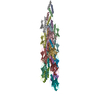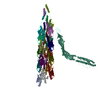+ Open data
Open data
- Basic information
Basic information
| Entry | Database: PDB / ID: 8tux | ||||||||||||||||||||||||
|---|---|---|---|---|---|---|---|---|---|---|---|---|---|---|---|---|---|---|---|---|---|---|---|---|---|
| Title | Capsid of mature PP7 virion with 3'end region of PP7 genomic RNA | ||||||||||||||||||||||||
 Components Components |
| ||||||||||||||||||||||||
 Keywords Keywords |  VIRAL PROTEIN / Maturation protein / PP7 / pepevirus VIRAL PROTEIN / Maturation protein / PP7 / pepevirus | ||||||||||||||||||||||||
| Function / homology |  Function and homology information Function and homology informationvirion attachment to host cell pilus / T=3 icosahedral viral capsid /  virion component / virion component /  regulation of translation / symbiont entry into host cell / regulation of translation / symbiont entry into host cell /  RNA binding / identical protein binding RNA binding / identical protein bindingSimilarity search - Function | ||||||||||||||||||||||||
| Biological species |  Pseudomonas phage PP7 (virus) Pseudomonas phage PP7 (virus) | ||||||||||||||||||||||||
| Method |  ELECTRON MICROSCOPY / ELECTRON MICROSCOPY /  single particle reconstruction / single particle reconstruction /  cryo EM / Resolution: 3.9 Å cryo EM / Resolution: 3.9 Å | ||||||||||||||||||||||||
 Authors Authors | Thongchol, J. / Zhang, J. / Zeng, L. | ||||||||||||||||||||||||
| Funding support |  United States, 7items United States, 7items
| ||||||||||||||||||||||||
 Citation Citation |  Journal: Science / Year: 2024 Journal: Science / Year: 2024Title: Removal of type IV pili by a small RNA virus. Authors: Jirapat Thongchol / Zihao Yu / Laith Harb / Yiruo Lin / Matthias Koch / Matthew Theodore / Utkarsh Narsaria / Joshua Shaevitz / Zemer Gitai / Yinghao Wu / Junjie Zhang / Lanying Zeng /  Abstract: The retractile type IV pilus (T4P) is important for virulence of the opportunistic human pathogen . The single-stranded RNA (ssRNA) phage PP7 binds to T4P and is brought to the cell surface through ...The retractile type IV pilus (T4P) is important for virulence of the opportunistic human pathogen . The single-stranded RNA (ssRNA) phage PP7 binds to T4P and is brought to the cell surface through pilus retraction. Using fluorescence microscopy, we discovered that PP7 detaches T4P, which impairs cell motility and restricts the pathogen's virulence. Using cryo-electron microscopy, mutagenesis, optical trapping, and Langevin dynamics simulation, we resolved the structure of PP7, T4P, and the PP7/T4P complex and showed that T4P detachment is driven by the affinity between the phage maturation protein and its bound pilin, plus the pilus retraction force and speed, and pilus bending. Pilus detachment may be widespread among other ssRNA phages and their retractile pilus systems and offers new prospects for antibacterial prophylaxis and therapeutics. | ||||||||||||||||||||||||
| History |
|
- Structure visualization
Structure visualization
| Structure viewer | Molecule:  Molmil Molmil Jmol/JSmol Jmol/JSmol |
|---|
- Downloads & links
Downloads & links
- Download
Download
| PDBx/mmCIF format |  8tux.cif.gz 8tux.cif.gz | 4.3 MB | Display |  PDBx/mmCIF format PDBx/mmCIF format |
|---|---|---|---|---|
| PDB format |  pdb8tux.ent.gz pdb8tux.ent.gz | Display |  PDB format PDB format | |
| PDBx/mmJSON format |  8tux.json.gz 8tux.json.gz | Tree view |  PDBx/mmJSON format PDBx/mmJSON format | |
| Others |  Other downloads Other downloads |
-Validation report
| Arichive directory |  https://data.pdbj.org/pub/pdb/validation_reports/tu/8tux https://data.pdbj.org/pub/pdb/validation_reports/tu/8tux ftp://data.pdbj.org/pub/pdb/validation_reports/tu/8tux ftp://data.pdbj.org/pub/pdb/validation_reports/tu/8tux | HTTPS FTP |
|---|
-Related structure data
| Related structure data |  41632MC  8tumC  8tuwC M: map data used to model this data C: citing same article ( |
|---|---|
| Similar structure data | Similarity search - Function & homology  F&H Search F&H Search |
- Links
Links
- Assembly
Assembly
| Deposited unit | 
|
|---|---|
| 1 |
|
- Components
Components
| #1: RNA chain | Mass: 30456.055 Da / Num. of mol.: 1 / Source method: isolated from a natural source / Source: (natural)  Pseudomonas phage PP7 (virus) / References: GenBank: NC_001628 Pseudomonas phage PP7 (virus) / References: GenBank: NC_001628 | ||
|---|---|---|---|
| #2: Protein | Mass: 50763.766 Da / Num. of mol.: 2 / Source method: isolated from a natural source / Source: (natural)  Pseudomonas phage PP7 (virus) / References: UniProt: Q38061 Pseudomonas phage PP7 (virus) / References: UniProt: Q38061#3: Protein |  Capsid / CP / Coat protein Capsid / CP / Coat proteinMass: 13906.811 Da / Num. of mol.: 178 / Source method: isolated from a natural source / Source: (natural)  Pseudomonas phage PP7 (virus) / References: UniProt: P03630 Pseudomonas phage PP7 (virus) / References: UniProt: P03630 |
-Experimental details
-Experiment
| Experiment | Method:  ELECTRON MICROSCOPY ELECTRON MICROSCOPY |
|---|---|
| EM experiment | Aggregation state: PARTICLE / 3D reconstruction method:  single particle reconstruction single particle reconstruction |
- Sample preparation
Sample preparation
| Component | Name: Pseudomonas phage PP7 / Type: COMPLEX Details: Maturation proteins of PP7, 3'end region of PP7 genomic RNA, coat protein shell of PP7 Entity ID: all / Source: NATURAL |
|---|---|
| Molecular weight | Experimental value: NO |
| Source (natural) | Organism:  Pseudomonas phage PP7 (virus) Pseudomonas phage PP7 (virus) |
| Details of virus | Empty: NO / Enveloped: NO / Isolate: SPECIES / Type: VIRION |
| Natural host | Organism: Pseudomonas aeruginosa |
| Virus shell | Diameter: 280 nm |
| Buffer solution | pH: 7.4 Details: 137 mM NaCl, 2.7 mM KCl, 8 mM Na2HPO4, and 2 mM KH2PO4, pH 7.4 |
| Buffer component | Conc.: 1 x / Name: PBS |
| Specimen | Embedding applied: NO / Shadowing applied: NO / Staining applied : NO / Vitrification applied : NO / Vitrification applied : YES : YES |
Vitrification | Cryogen name: ETHANE |
- Electron microscopy imaging
Electron microscopy imaging
| Experimental equipment |  Model: Titan Krios / Image courtesy: FEI Company |
|---|---|
| Microscopy | Model: FEI TITAN KRIOS |
| Electron gun | Electron source : :  FIELD EMISSION GUN / Accelerating voltage: 300 kV / Illumination mode: FLOOD BEAM FIELD EMISSION GUN / Accelerating voltage: 300 kV / Illumination mode: FLOOD BEAM |
| Electron lens | Mode: BRIGHT FIELD Bright-field microscopy / Nominal defocus max: 2200 nm / Nominal defocus min: 1200 nm Bright-field microscopy / Nominal defocus max: 2200 nm / Nominal defocus min: 1200 nm |
| Image recording | Electron dose: 51.5 e/Å2 / Film or detector model: GATAN K3 (6k x 4k) |
- Processing
Processing
| EM software |
| |||||||||
|---|---|---|---|---|---|---|---|---|---|---|
CTF correction | Type: PHASE FLIPPING AND AMPLITUDE CORRECTION | |||||||||
| Symmetry | Point symmetry : C1 (asymmetric) : C1 (asymmetric) | |||||||||
3D reconstruction | Resolution: 3.9 Å / Resolution method: FSC 0.5 CUT-OFF / Num. of particles: 644601 / Symmetry type: POINT |
 Movie
Movie Controller
Controller







 PDBj
PDBj






























